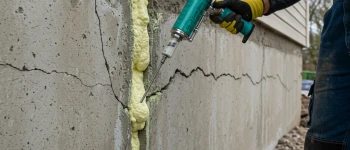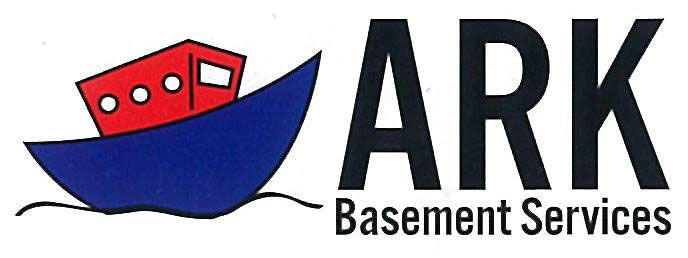As a homeowner with concrete block walls, you’ll know that foundation sealing is essential for preventing water damage and maintaining the structure’s stability. You’ve likely inspected for cracks, cleaned surfaces, and even selected a high-quality sealant. But, have you pondered the best application conditions or upkeep methods? Let’s discuss the overlooked details that can make all the difference in the longevity and effectiveness of your foundation sealing.
Key Takeaways
- Regularly inspect concrete block walls for cracks or holes before applying sealant.
- Choose the right sealant considering factors like freeze-thaw protection and aesthetic finish.
- Prepare walls by cleaning surfaces to remove dirt and loose particles before sealing.
- Address common sealing issues like cracked or peeling sealant and unsealed areas with water seepage.
- Implement regular cleaning and environmental assessments to prolong sealant life and maintain wall integrity.
Understanding Concrete Block Walls
 Did you know that over 80% of buildings are made of concrete block walls? That’s because they’re cost-effective, sturdy, and versatile. But you must understand what they’re all about to maintain them properly.
Did you know that over 80% of buildings are made of concrete block walls? That’s because they’re cost-effective, sturdy, and versatile. But you must understand what they’re all about to maintain them properly.
Concrete block walls, also known as cinder block walls, are typically used in the construction of buildings for their durability and resilience. They’re made from concrete and cinder aggregates, which are then molded into blocks. These blocks are stacked and held together with mortar, creating a strong and sturdy wall structure.
When you’re dealing with these walls, it’s crucial to know that they’ve a porous nature. That means they can absorb moisture, leading to potential problems like mold growth, water damage, and structural instability. This is why they require regular maintenance and care, such as applying a protective coating or sealant.
However, remember not to confuse this with foundation sealing, a different process altogether with its own set of rules and techniques.
You’ll discover more about that in the next part of this article, “Importance of Foundation Sealing.” But for now, understanding the basics of your concrete block walls is your first step towards informed maintenance.
Importance of Foundation Sealing
As you’ve learned about the nature of concrete block walls, you might now wonder about the role of foundation sealing. It’s a crucial step you shouldn’t overlook, and here’s why.
Foundation sealing acts as a barrier, protecting your home from the elements. It prevents water from seeping into your home’s foundation, which can lead to costly structural damage over time. Without it, you could be looking at significant repair costs down the line.
In addition to water damage, unsealed foundations can also invite unwanted pests. Cracks and crevices in concrete blocks provide the perfect entry point for critters, and once inside, they can wreak havoc on your home. Sealing your foundation doesn’t just help protect your investment, it also preserves your peace of mind.
Furthermore, foundation sealing can also help to regulate the temperature in your home. It acts as an insulator, reducing heat loss during the winter and preventing cool air from escaping during the summer months.
This means you could be saving on energy costs while keeping your home comfortable year-round.
Pre-Sealing Preparation Steps
Before you immerse yourself in the process of sealing, there are several preparation steps you’ll need to take.
First off, you’ll need to thoroughly inspect your concrete block wall. Look for any existing cracks or holes that’ll need to be addressed before sealing. It’s vital to repair these issues upfront, as they can undermine the effectiveness of the sealant.
Then, move on to cleaning. Make sure to remove any dirt, dust, or loose particles from the surface. This step is important because a clean surface helps the sealant to adhere better.
Next, you’ll need to check the weather forecast. It’s best to apply sealant on a dry day with moderate temperatures. This allows the sealant to cure properly without being affected by rain or extreme heat.
Lastly, make sure to gather all your tools and safety gear. You’ll need brushes or rollers to apply the sealant, a ladder if necessary, and safety gear like gloves and goggles.
Choosing the Right Sealant
Steering through the sea of sealants can be intimidating, but we’ll help simplify it for you. When it comes to concrete block walls, you’re primarily looking at two types of sealants: silanes/siloxanes and silicate sealers.
Silanes/Siloxanes are penetrating sealers. They seep into your walls and react chemically to create a waterproof barrier. They’re great for preventing damage from freeze-thaw cycles and de-icing salts. However, they’re not aesthetic-friendly, so if you’re looking for a glossy finish, they might not be your first pick.
Silicate sealers, on the other hand, create a thin, hard surface that prevents water from seeping through. They’re more durable but can leave a white, hazy finish.
Here’s a quick comparison table to guide you:
| Sealer Type | Pros | Cons |
|---|---|---|
| Silanes/Siloxanes | Excellent at preventing freeze-thaw damage, Doesn’t change wall appearance | Not glossy |
| Silicates | Durable, Creates a hard surface | Can leave a white, hazy finish |
Foundation Sealing Process Explained
Now that you’ve chosen the right sealant, let’s get a clear understanding of the foundation sealing process.
Knowing what materials you’ll need is key in ensuring the job is done right.
From there, we’ll walk through the step-by-step process of sealing your concrete block wall’s foundation.
Understanding Foundation Sealing
Without a doubt, understanding foundation sealing is essential to maintaining the integrity of concrete block walls. Foundation sealing is the process you apply to prevent water from seeping into the basement or crawl space of your home. It’s a critical step to protect your property from potential water damage.
Now, you might be wondering, why is foundation sealing so important? Well, over time, water seepage can lead to mold growth and structural damage, both of which can be costly to fix. By sealing the foundation, you’re building a barrier that combats moisture infiltration. This barrier not only keeps your home dry but also improves its longevity.
It’s also important to know when sealing is necessary. If you spot signs of seepage, such as damp walls or a musty smell, it’s time to evaluate foundation sealing. Even if your home seems dry, it’s a good idea to inspect the foundation regularly. Changes in soil conditions or a shift in the landscape can create new pathways for water, making your foundation vulnerable.
Understanding foundation sealing helps you preserve your home’s value while ensuring a comfortable, dry living environment. Don’t underestimate the significance of this preventative measure!
Necessary Sealing Materials
Before you plunge into the task of sealing your foundation, it’s crucial to gather all the necessary materials.
First, you’ll need a high-quality concrete sealant. Opt for a waterproof sealant specifically designed for concrete blocks to guarantee maximum protection.
Next up is a sealant applicator. This could be a simple paintbrush for small areas or a roller for larger surfaces. A sprayer can also be useful for applying the sealant more evenly.
To prepare the surface, you’ll need a wire brush to remove any loose debris and a heavy-duty cleaner to remove dirt and grime.
It’s also a good idea to have a bucket and water on hand for mixing and clean up purposes.
Safety is paramount, so don’t forget your personal protective equipment. This includes safety goggles to protect your eyes, gloves to keep your hands clean and safe, and a mask to prevent inhalation of harmful fumes.
Steps in Sealing Process
Beginning the journey to seal your concrete block walls, you’ll find that there are five essential steps to follow.
First, you’ll need to clean the surface. Use a stiff-bristle brush to remove any loose debris or dirt. For tough stains or mildew, you might need a power washer or a specialized cleaning solution.
The second step is to repair any cracks or holes. Use a concrete patching compound for this, applying it with a trowel and smoothing it out. Make sure it’s completely dry before you move on.
Third, apply a concrete sealer. This will help prevent water damage and increase the longevity of your walls. Use a roller or sprayer for large areas, and a brush for smaller, more detailed work.
Fourth, you’ll want to paint the walls. Opt for a paint specifically designed for concrete and masonry. Let the first coat dry thoroughly before applying a second for best results.
Post-Sealing Maintenance Tips
After you’ve sealed your concrete block walls, maintenance becomes a critical part of the process to guarantee longevity.
It’s not just about keeping the blocks looking good, it’s about preserving the sealant’s effectiveness. So, what should you do?
First, inspect your walls regularly. A quick monthly check will suffice. Look for visible signs of wear, such as cracked or peeling sealant.
Don’t wait for damage to escalate. If you spot any issues, address them promptly to prevent further deterioration.
Next, clean your walls. Dust and debris build-up can impair the sealant’s performance.
You’ll need to gently clean the walls, using warm soapy water and a soft-bristled brush. Be careful not to scrub too hard, as it might damage the sealant.
Finally, monitor the moisture levels around your home. Too much moisture can cause the sealant to degrade faster.
Consider installing a dehumidifier if you live in a particularly damp region.
Troubleshooting Common Sealing Issues

Even with meticulous maintenance, you might still encounter some sealing issues with your concrete block walls.
Don’t panic. It’s essential you know how to troubleshoot these problems to prevent damage.
Here are three common issues:
- Cracked Sealer: Over time, sealants can crack due to weather changes or pressure.
You’ll notice this as small, hairline fractures in the sealant. To fix this, you’ll need to remove the old sealant and apply a fresh layer.
- Peeling Sealer: If your sealant starts peeling, it’s likely due to improper application or moisture intrusion.
Correct this by scraping off the peeling sealer, drying the area thoroughly, and reapplying the sealant.
- Water Seepage: This could be a sign that the sealant isn’t adhering correctly.
In this case, you’ll need to assess the entire wall for any unsealed areas and reapply the sealant.
Conclusion
So, you’ve got the lowdown on sealing concrete block walls. Remember, it’s all about proper prep, picking the right sealant, and diligent upkeep. Don’t skimp on these steps – they’re essential in keeping moisture out and your home safe. Keep an eye out for peeling or cracks, and act swiftly if you spot any issues. With these tips, you’re well on your way to maintaining a well-sealed concrete block wall foundation. Good luck!



